Kolmogorov-Arnold-Moser Theory and Symmetries for a Polynomial Quadratic Second Order Difference Equation
Abstract
1. Introduction and Preliminaries
- 1.
- For the equilibrium is a saddle point.
- 2.
- For the equilibrium is non-hyperbolic of the parabolic type.
- 3.
- For the equilibrium is non-hyperbolic of the elliptic type.
- for and or ,
- for and for ,
- for .
- 1.
- For the positive equilibrium is a saddle point.
- 2.
- For the negative equilibrium is non-hyperbolic of the elliptic type.
- 3.
- For the negative equilibrium is non-hyperbolic of the parabolic type.
- 4.
- For the negative equilibrium is a saddle point.
- , for .
- for and .
- for .
- for
2. KAM Theory Applied to Equation (1)
3. Periodic Points and Orbits
- 1.
- a saddle point for
- 2.
- non-hyperbolic of the parabolic type for
- 3.
- non-hyperbolic of the elliptic type for
4. Symmetries
5. Conclusions
Author Contributions
Funding
Acknowledgments
Conflicts of Interest
References
- Bektešević, J.; Kulenović, M.R.S.; Pilav, E. Global dynamics of quadratic second order difference equation in the first quadrant. Appl. Math. Comput. 2014, 227, 50–65. [Google Scholar] [CrossRef]
- Bektešević, J.; Kulenović, M.R.S.; Pilav, E. Asymptotic approximations of a stable and unstable manifolds of a two-dimensional quadratic map. J. Comp. Anal. Appl. 2016, 21, 35–51. [Google Scholar]
- Bedford, E. Complex Hénon maps with semi-parabolic fixed points. J. Differ. Equ. Appl. 2010, 16, 425–426. [Google Scholar] [CrossRef]
- Bedford, E.; Smillie, J. Real polynomial diffeomorphisms with maximal entropy: Tangencies. Ann. Math. 2004, 160, 1–26. [Google Scholar] [CrossRef]
- Milnor, J. Dynamics in One Complex Variable. (AM-160), 3rd ed.; Princeton University Press: Princenton, NJ, USA; Oxford, UK, 2011; p. 160. ISBN 9781400835539. [Google Scholar]
- Ilyashenko, Y. Centennial history of Hilbert’s 16th problem. Bull. Am. Math. Soc. (N.S.) 2002, 39, 301–354. [Google Scholar] [CrossRef]
- Bektešević, J.; Kulenović, M.R.S.; Pilav, E. Global dynamics of cubic second order difference equation in the first quadrant. Adv. Differ. Equ. 2015, 176, 2015. [Google Scholar] [CrossRef][Green Version]
- Kulenović, M.R.S.; Merino, O. Discrete Dynamical Systems and Difference Equations with Mathematica; Chapman and Hall/CRC: Boca Raton, FL, USA; London, UK, 2002. [Google Scholar]
- Bastien, G.; Rogalski, M. On the algebraic difference equations un+2un = ψ(un+1) in ℝ+, related to a family of elliptic quartics in the plane. Adv. Differ. Equ. 2005, 3, 227–261. [Google Scholar] [CrossRef]
- Bastien, G.; Rogalski, M. On the algebraic difference equations un+2 + un = ψ(un+1) in ℝ, related to a family of elliptic quartics in the plane. J. Math. Anal. Appl. 2007, 326, 822–844. [Google Scholar] [CrossRef]
- Cima, A.; Gasull, A.; Mańosa, V. Dynamics of rational discrete dynamical systems via first integrals. Int. J. Bifur. Chaos Appl. Sci. Eng. 2006, 16, 631–645. [Google Scholar] [CrossRef]
- Del-Castillo-Negrete, D.; Greene, J.M.; Morrison, E.J. Area preserving nontwist maps: periodic orbits and transition to chaos. Physica D 1996, 91, 1–23. [Google Scholar] [CrossRef]
- Garić-Demirović, M.; Nurkanović, M.; Nurkanović, Z. Stability, periodicity and symmetries of certain second-order fractional difference equation with quadratic terms via KAM theory. Math. Methods Appl. Sci. 2017, 40, 306–318. [Google Scholar] [CrossRef]
- Hrustić, S.J.; Kulenović, M.R.S.; Nurkanović, Z.; Pilav, E. Birkhoff normal forms, KAM theory and symmetries for certain second order rational difference equation with quadratic term. Int. J. Differ. Equ. 2015, 10, 181–199. [Google Scholar]
- Janowski, E.J.; Kulenović, M.R.S.; Nurkanović, Z. Stability of the k-th Order Lyness’ Equation with a Period-k Coefficient. Int. J. Bifur. Chaos Appl. Sci. Eng. 2007, 17, 143–152. [Google Scholar] [CrossRef]
- Kulenović, M.R.S. Invariants and related Liapunov functions for difference equations. Appl. Math. Lett. 2000, 13, 1–8. [Google Scholar] [CrossRef]
- Kulenović, M.R.S.; Nurkanović, Z. Stability of Lyness’ Equation with Period-three Coeffcient. Rad. Mat. 2004, 12, 153–161. [Google Scholar]
- Kulenović, M.R.S.; Nurkanović, Z. Stability of Lyness’ Equation with Period-two Coeficient via KAM Theory. J. Concr. Appl. Math. 2008, 6, 229–245. [Google Scholar]
- Kulenović, M.R.S.; Nurkanović, Z.; Pilav, E. Birkhoff Normal Forms and KAM Theory for Gumowski-Mira Equation. Sci. World J. 2014, 2014, 819290. [Google Scholar] [CrossRef] [PubMed]
- Ladas, G.; Tzanetopoulos, G.; Tovbis, A. On May’s host parasitoid model. J. Differ. Equ. Appl. 1996, 2, 195–204. [Google Scholar] [CrossRef]
- Nurkanović, M.; Nurkanović, Z. Birkhoff Normal Forms, KAM Theory, periodicity and symmetries for certain rational difference equation with cubic terms. Sarajevo J. Math. 2016, 12, 217–231. [Google Scholar] [CrossRef]
- Beukers, F.; Cushman, R. Zeeman’s monotonicity conjecture. J. Differ. Equ. 1998, 143, 191–200. [Google Scholar] [CrossRef]
- Cima, A.; Gasull, A.; Mańosa, V. Non-autonomous two-periodic Gumowski-Mira difference equation. Int. J. Bifur. Chaos Appl. Sci. Eng. 2012, 16, 14. [Google Scholar]
- Cima, A.; Gasull, A.; Mańosa, V. Non-integrability of measure preserving maps via Lie symmetries. arxiv 2015, arXiv:1503.05348. [Google Scholar] [CrossRef]
- Clark, C.A.; Janowski, E.J.; Kulenović, M.R.S. Stability of the Gumowski-Mira equation with period-two coefficient. J. Math. Anal. Appl. 2005, 307, 292–304. [Google Scholar] [CrossRef]
- Kocic, V.L.; Ladas, G.; Tzanetopoulos, G.; Thomas, E. On the stability of Lyness’ equation. Dynam. Contin. Discrete Impuls. Syst. 1995, 1, 245–254. [Google Scholar]
- Zeeman, E.C. Geometric Unfolding of a Difference Equation; Preprint; Hertford College: Oxford, UK, 1996. [Google Scholar]
- Gidea, M.; Meiss, J.D.; Ugarcovici, I.; Weiss, H. Applications of KAM theory to population dynamics. J. Biol. Dyn. 2011, 5, 44–63. [Google Scholar] [CrossRef]
- Hale, J.K.; Kocak, H. Dynamics and Bifurcation; Springer: New York, NY, USA, 1991. [Google Scholar]
- Papaschinopoulos, G.; Schinas, C.J. Stability of a class of nonlinear difference equations. J. Math. Anal. Appl. 1999, 230, 211–222. [Google Scholar] [CrossRef]
- Tabor, M. Chaos and Integrability in Nonlinear Dynamics: An Introduction; A Wiley-Interscience Publication, John Wiley and Sons, Inc.: New York, NY, USA, 1989. [Google Scholar]
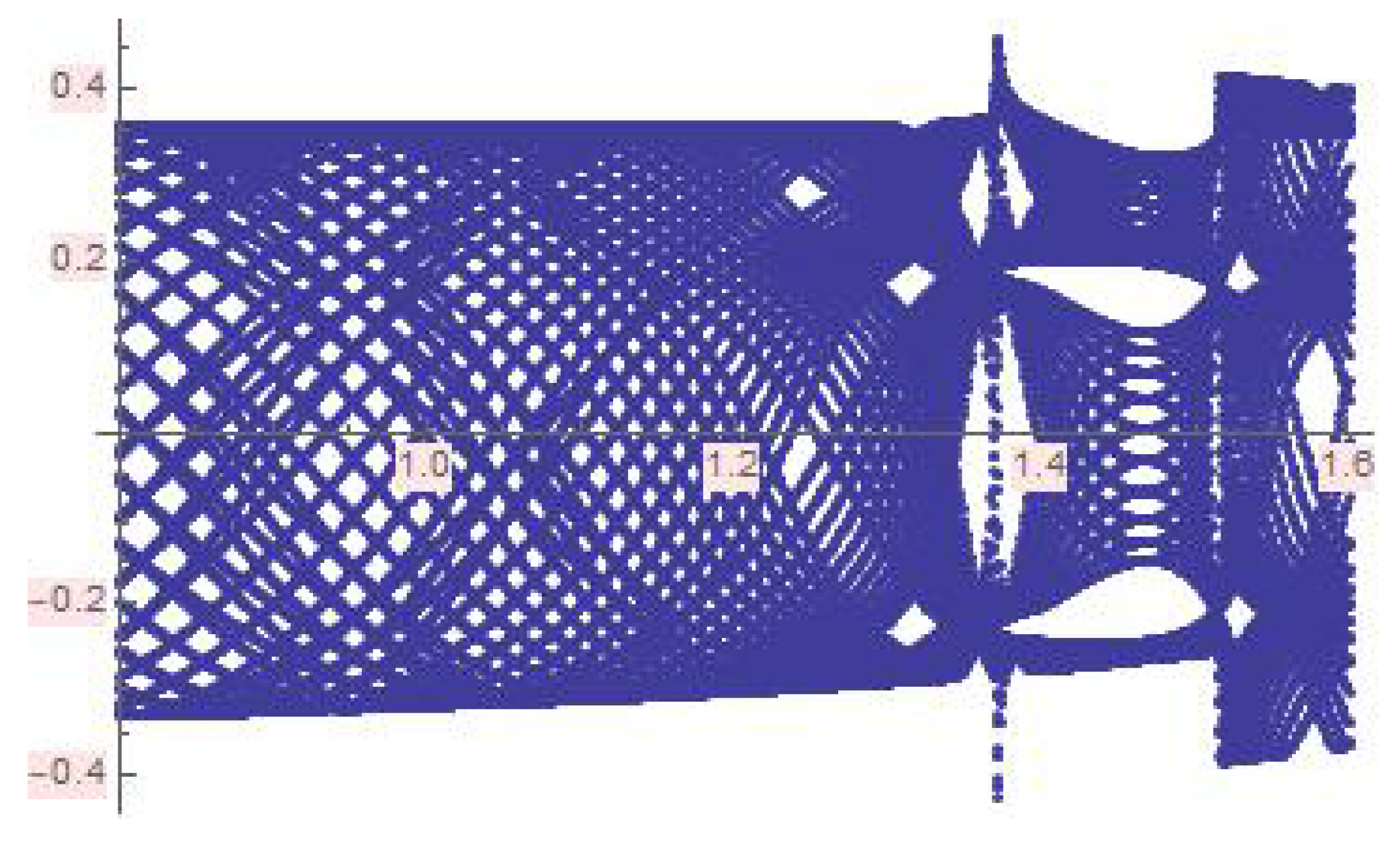
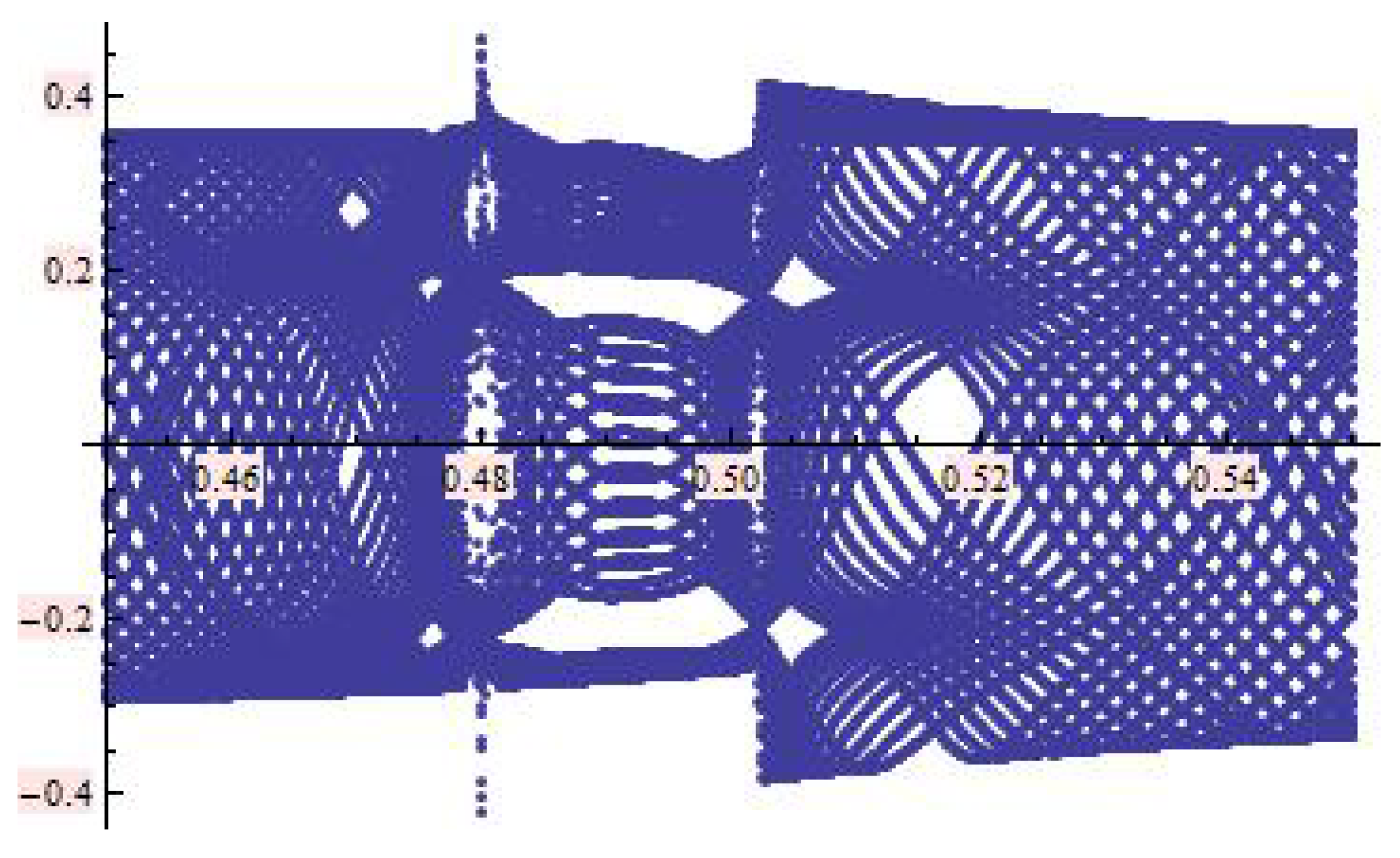
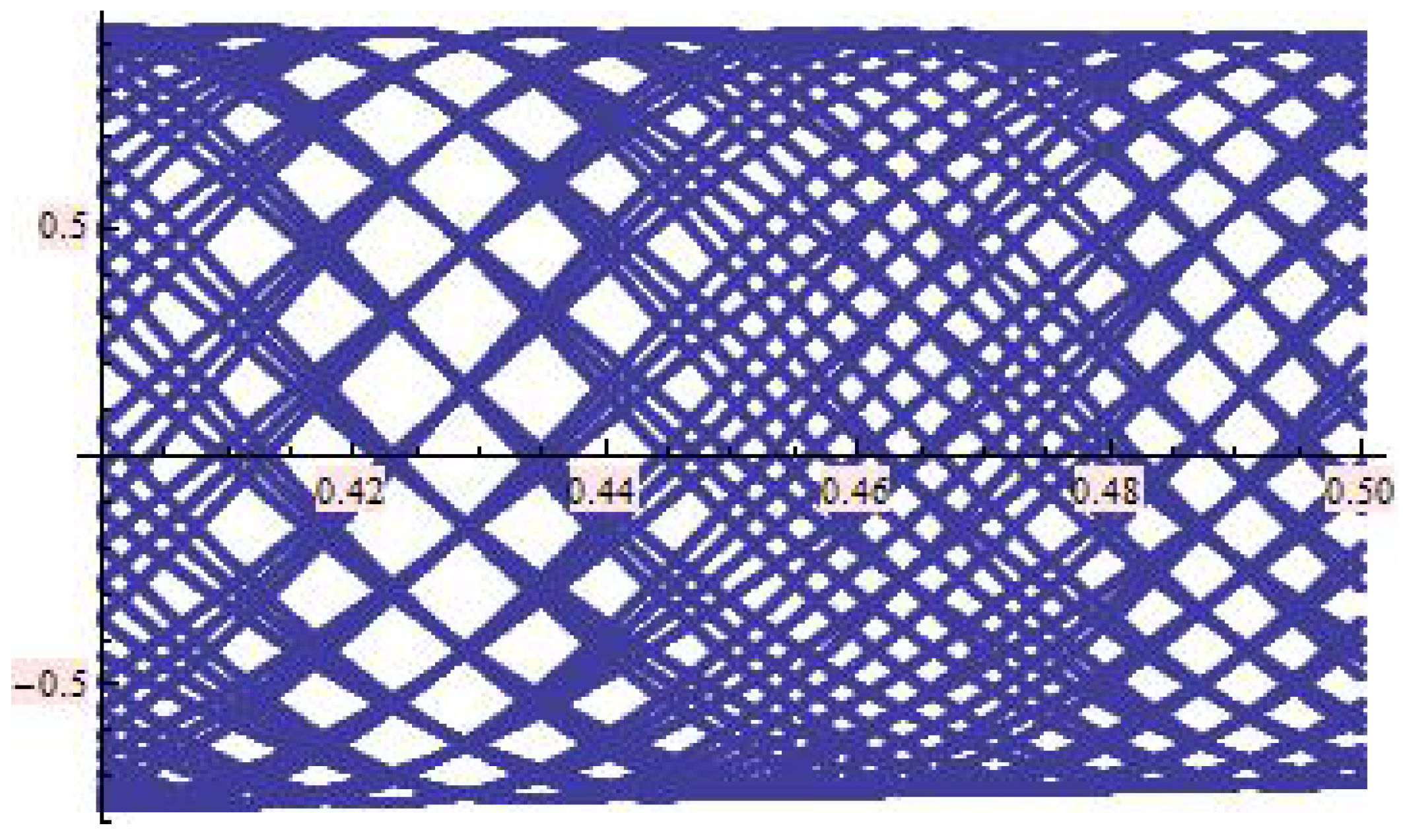
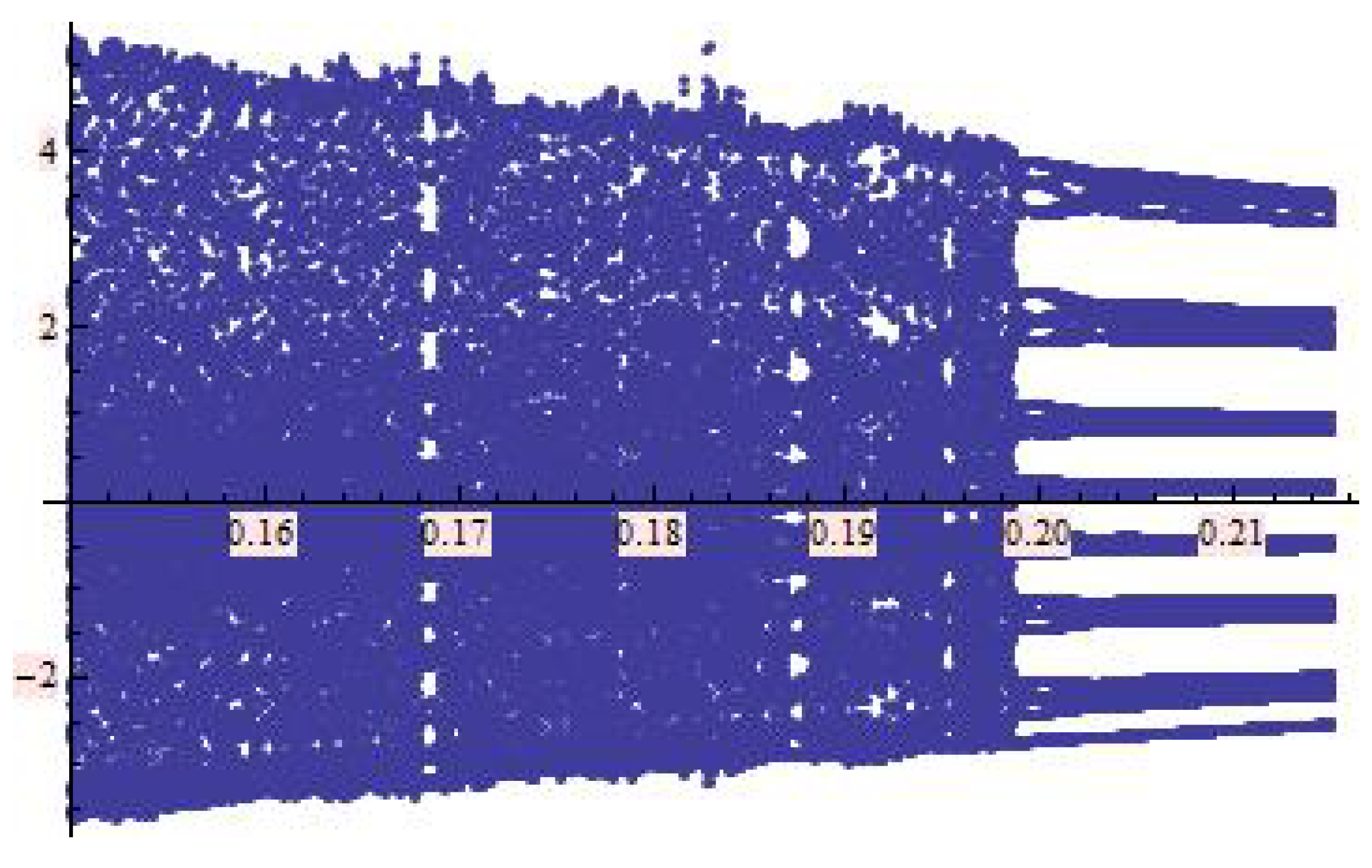
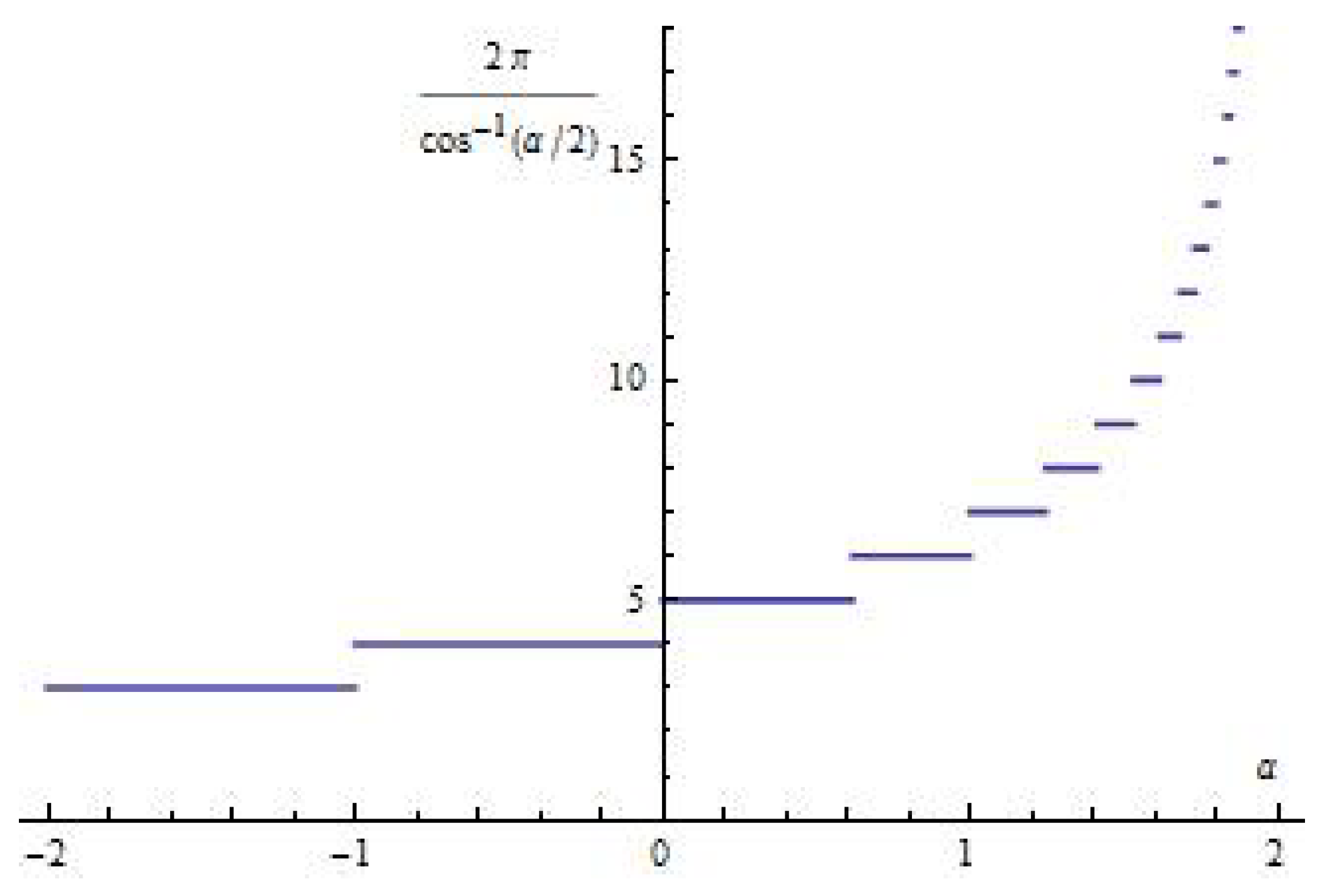

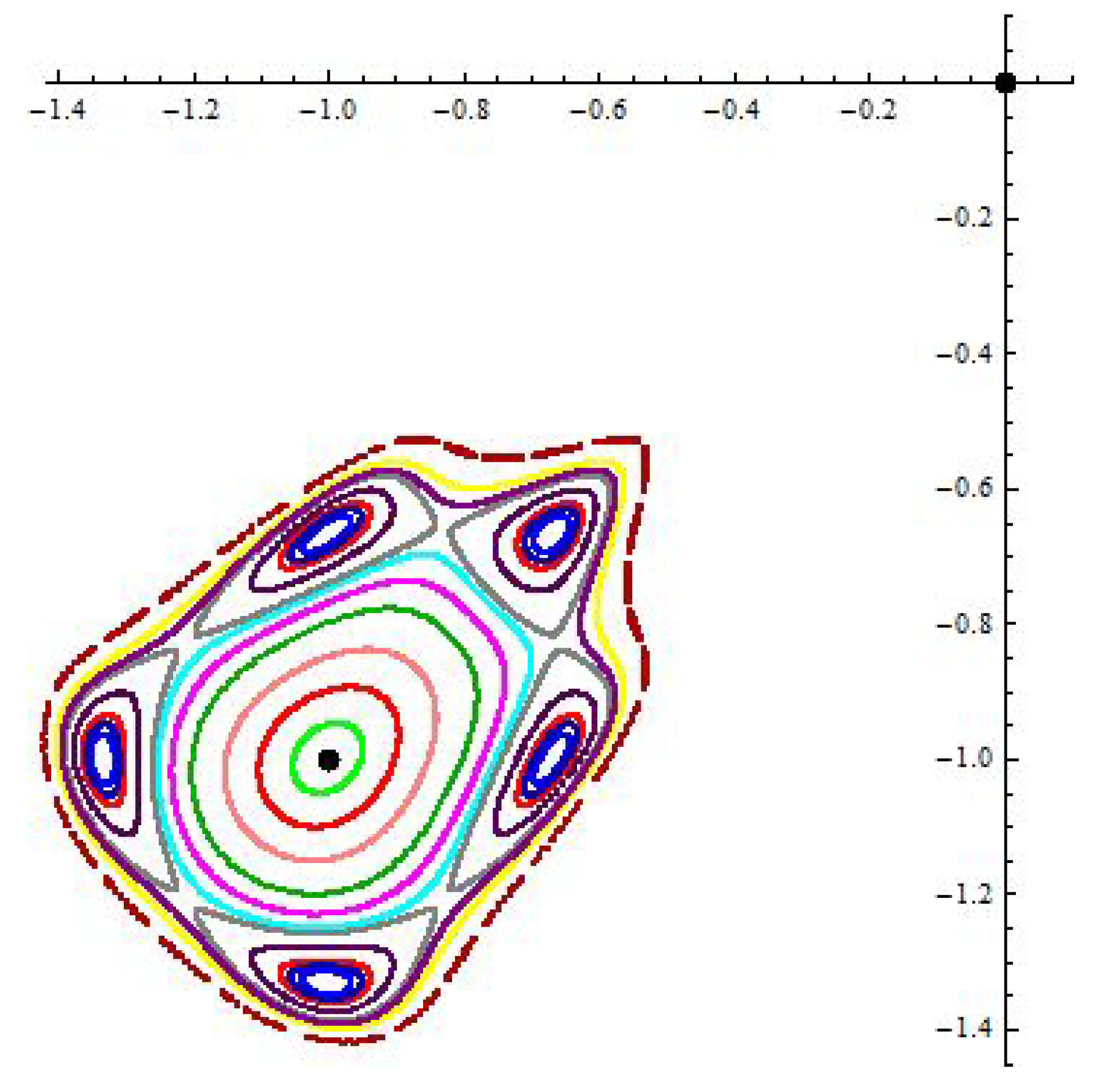
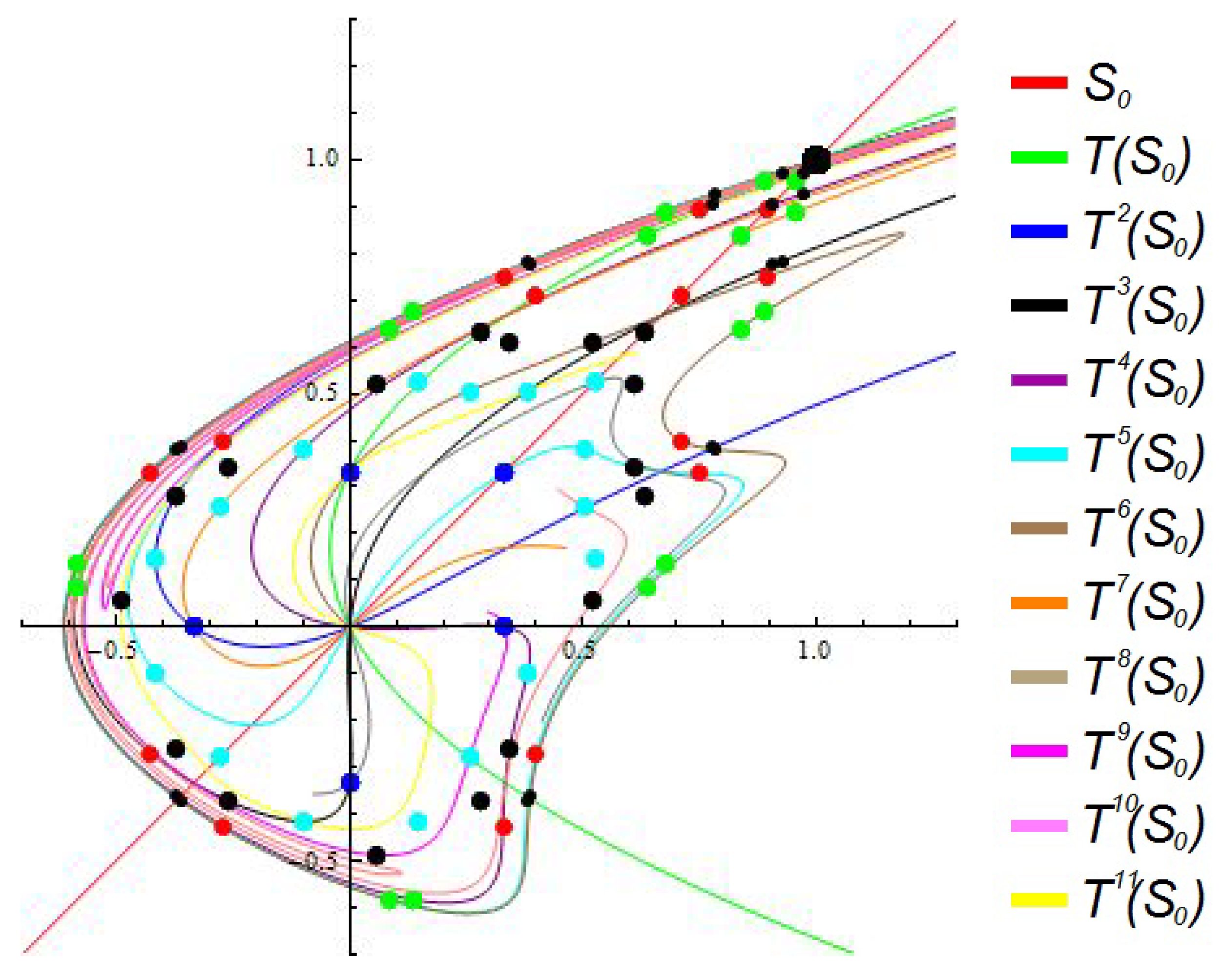
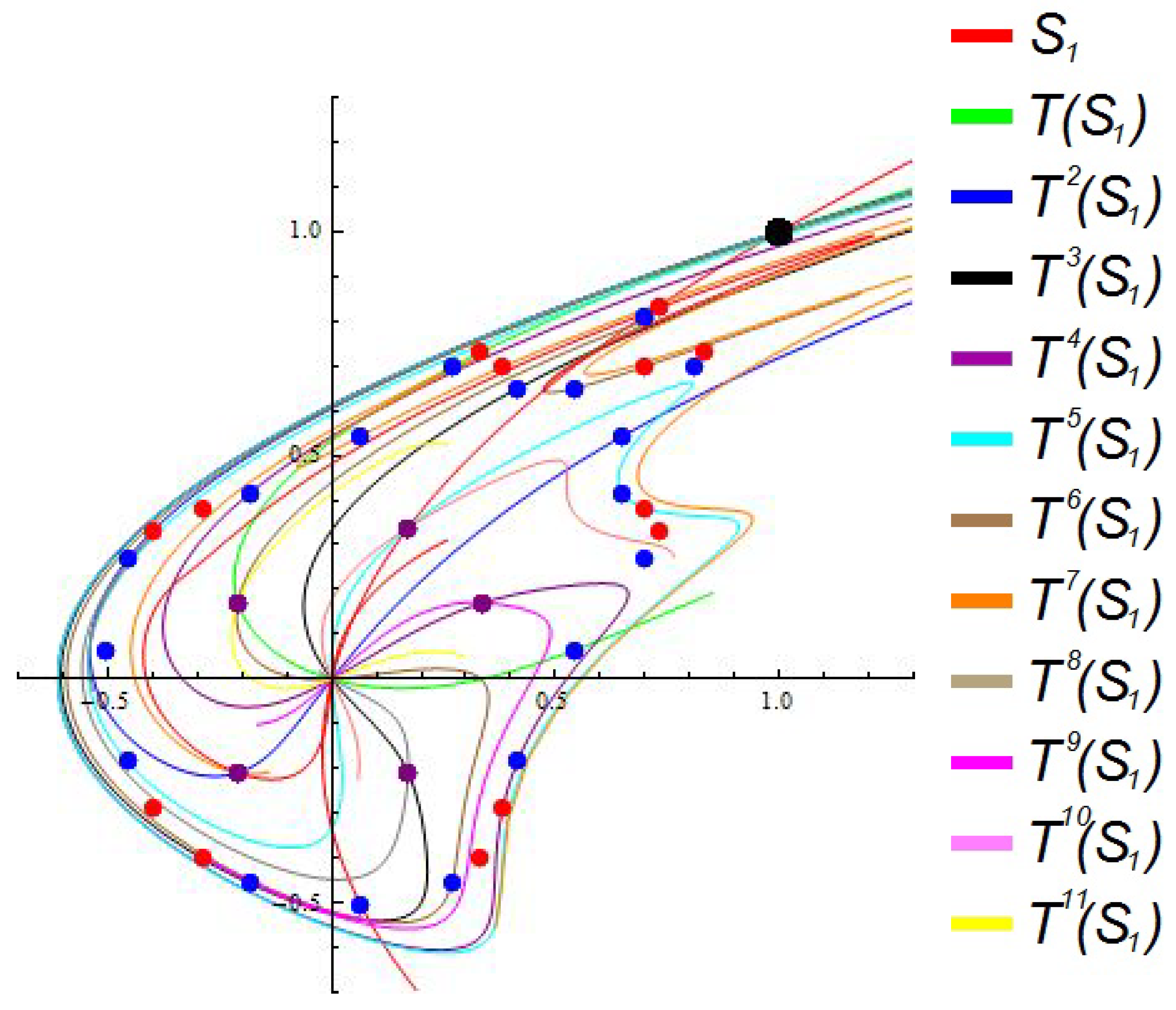
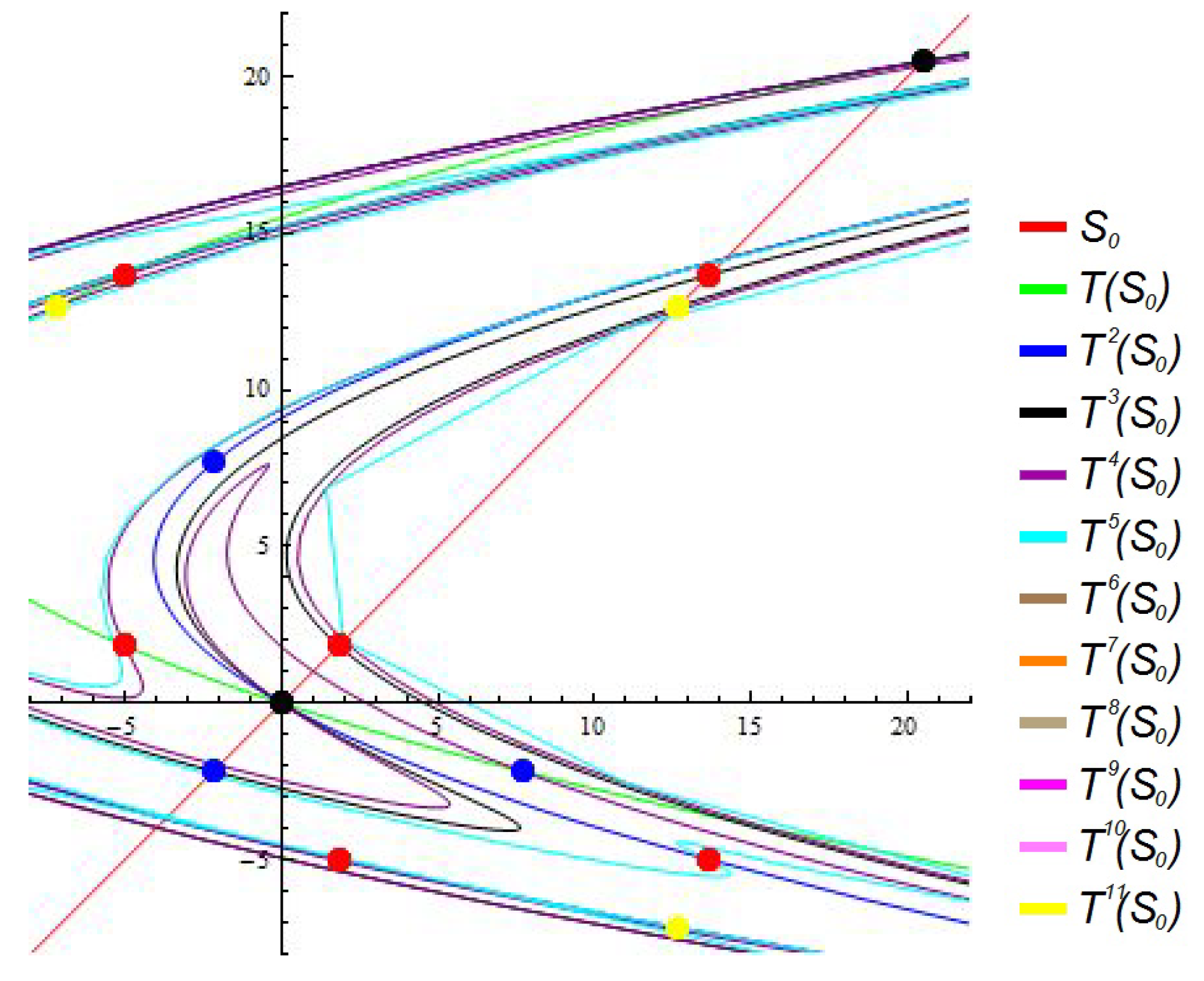
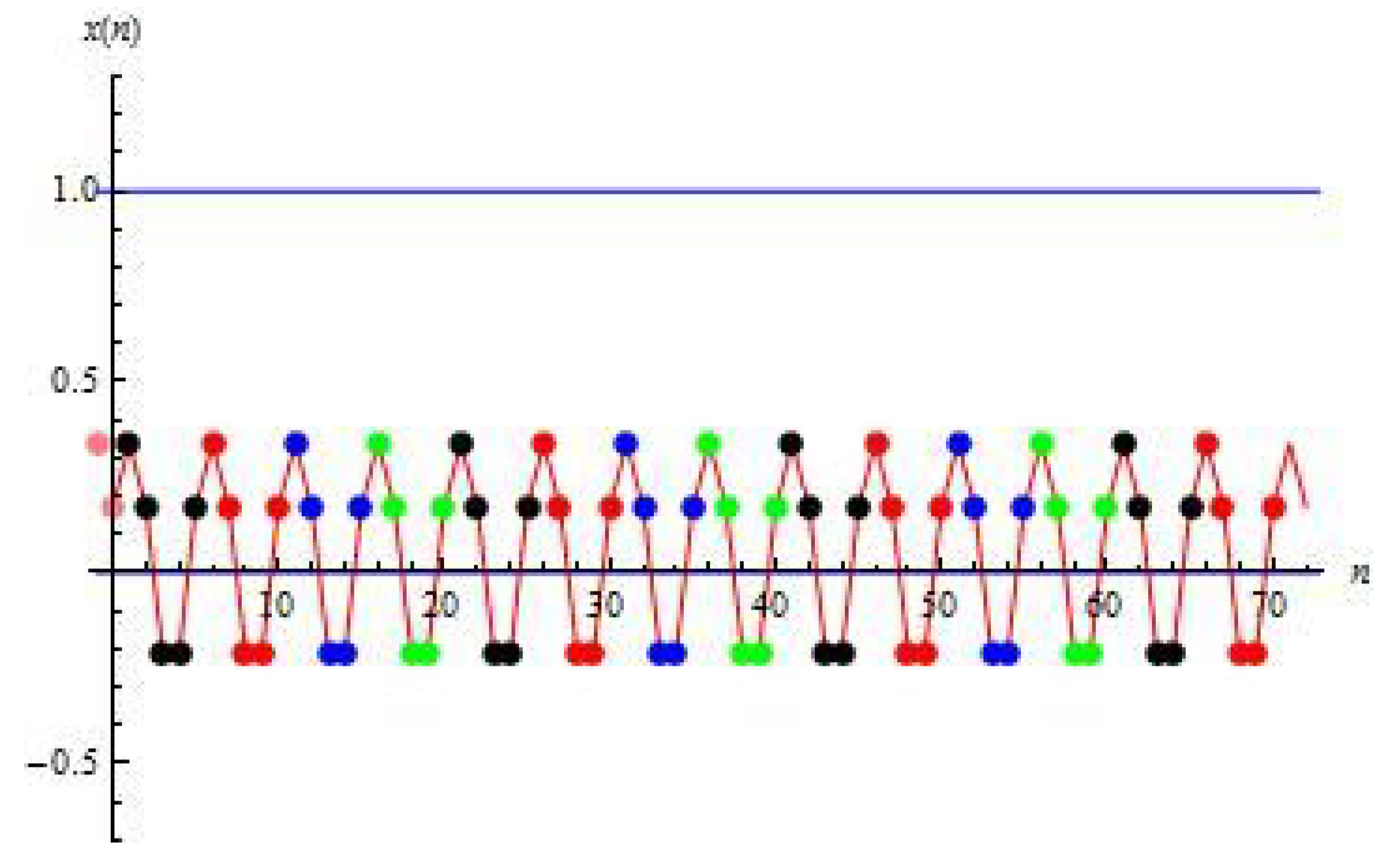
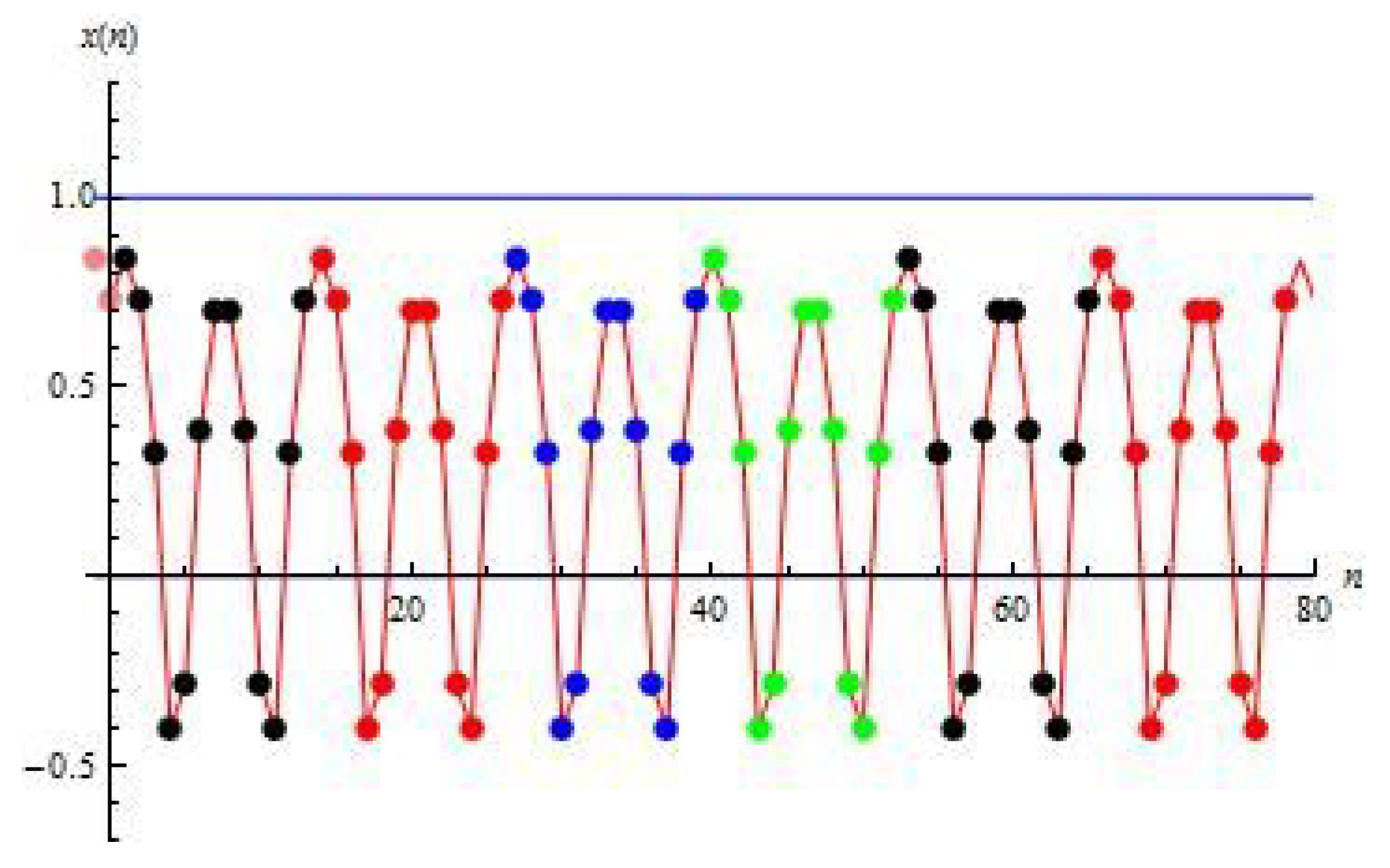
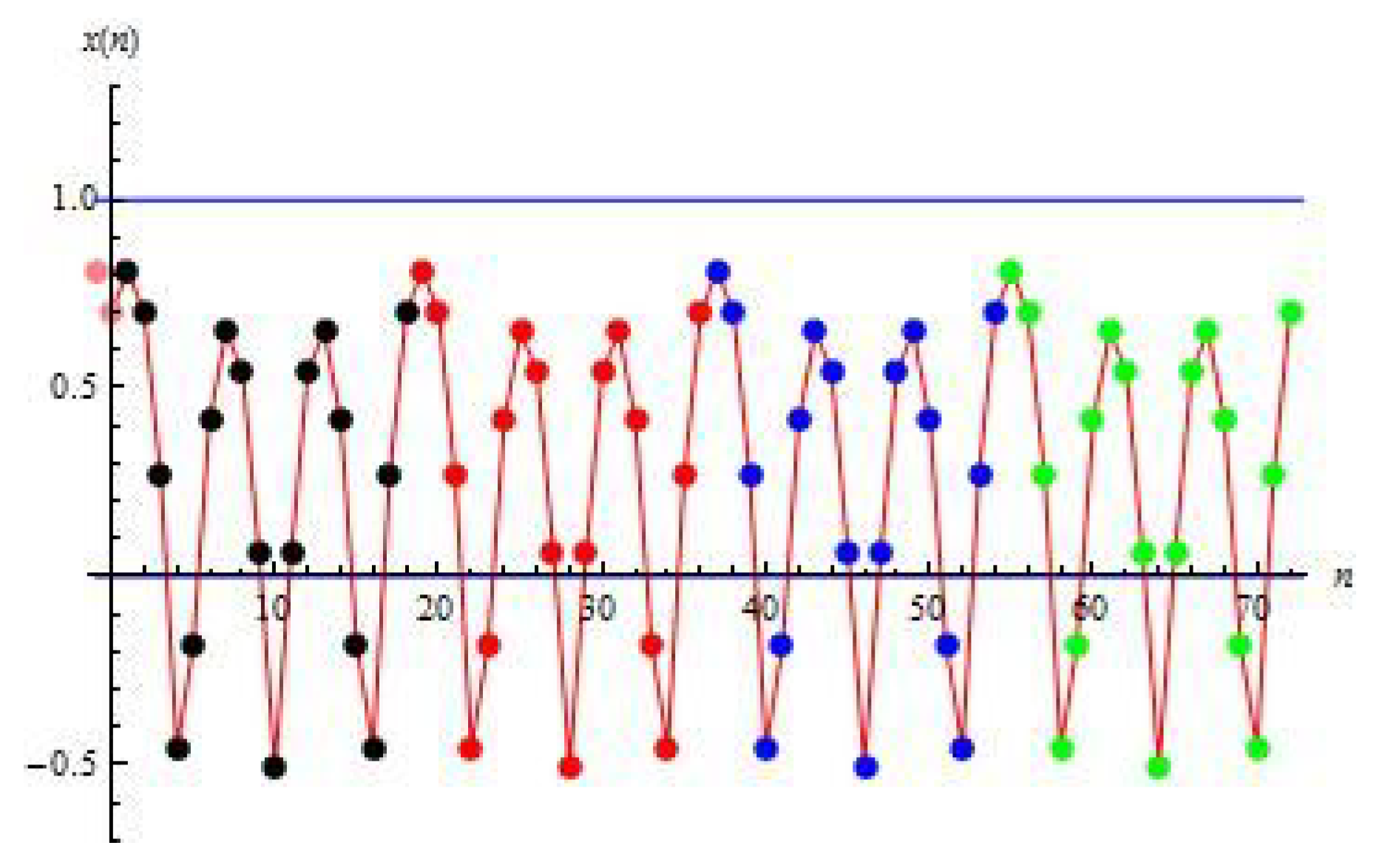
| P | Solution |
|---|---|
| 5 | |
| 13 | |
| 14 | |
| 16 | |
| 18 | |
| P | Solution |
|---|---|
| 2 | |
| 3 | |
| 3 | |
| 6 | |
| 14 | |
| 18 | |
© 2019 by the authors. Licensee MDPI, Basel, Switzerland. This article is an open access article distributed under the terms and conditions of the Creative Commons Attribution (CC BY) license (http://creativecommons.org/licenses/by/4.0/).
Share and Cite
Ibrahim, T.F.; Nurkanović, Z. Kolmogorov-Arnold-Moser Theory and Symmetries for a Polynomial Quadratic Second Order Difference Equation. Mathematics 2019, 7, 790. https://doi.org/10.3390/math7090790
Ibrahim TF, Nurkanović Z. Kolmogorov-Arnold-Moser Theory and Symmetries for a Polynomial Quadratic Second Order Difference Equation. Mathematics. 2019; 7(9):790. https://doi.org/10.3390/math7090790
Chicago/Turabian StyleIbrahim, Tarek F., and Zehra Nurkanović. 2019. "Kolmogorov-Arnold-Moser Theory and Symmetries for a Polynomial Quadratic Second Order Difference Equation" Mathematics 7, no. 9: 790. https://doi.org/10.3390/math7090790
APA StyleIbrahim, T. F., & Nurkanović, Z. (2019). Kolmogorov-Arnold-Moser Theory and Symmetries for a Polynomial Quadratic Second Order Difference Equation. Mathematics, 7(9), 790. https://doi.org/10.3390/math7090790





